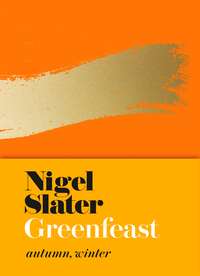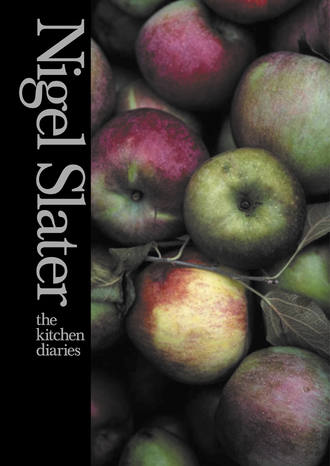
Полная версия
The Kitchen Diaries
Enough for 8
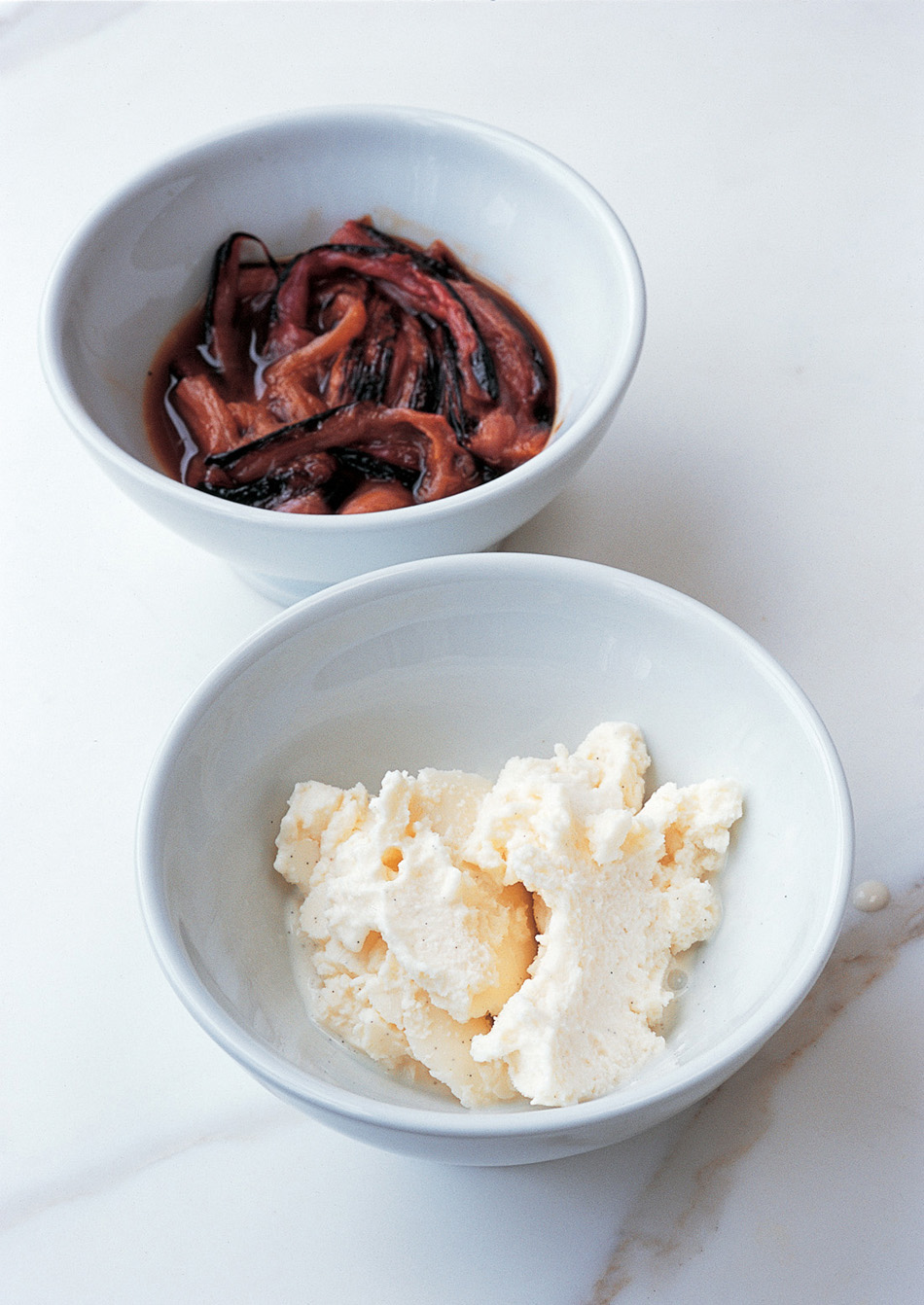
January 8
The first
rhubarb
The first rhubarb appears with impeccable timing. Just as you want a fresh start to the year, along come the pale pink stems of the most tart and clean-tasting fruit to cleanse and invigorate. I no longer cut the stems into chunks and dip each piece raw into the sugar bowl like I did when I was a kid, but I do poach it only very lightly, so that the stems retain their shape, then I eat it first thing in the morning, slurping up spoonfuls of its limpid pink juice.
Frozen yoghurt with roast rhubarb
Warm, rudely pink rhubarb and snow-white frozen yoghurt has a smart, bright flavour and is breathtakingly pretty on a cold winter’s day. The frozen yoghurt is simply a bought vanilla smoothie chucked into an ice-cream machine; the baked fruit just rhubarb bunged in a dish with a spoonful of runny honey and the juice of an orange.
thick vanilla yoghurt smoothies – 3 × 250ml
young, pink rhubarb – 500g
an orange
mild honey – a tablespoon
To make the frozen yoghurt, pour the smoothies into the drum of your ice-cream machine and churn till almost frozen. Scoop out and into a plastic freezer box, then keep in the freezer till you need it.
Cut the rhubarb into short lengths about the size of a wine cork. Lay them in a shallow stainless steel or glass baking dish, squeeze over the orange juice and drizzle with the honey. Bake for twenty-five minutes at 200°C/Gas 6, occasionally spooning the juices over the fruit. The rhubarb is done when the stalks are tender enough to crush between your fingers. Leave to cool a little.
Divide the warm rhubarb between four dishes, then place a couple of scoops of frozen yoghurt on each, though it looks rather elegant served in separate bowls.
Enough for 4
Note
To make the frozen yoghurt without a machine, pour the smoothies into a plastic box and freeze for a couple of hours till a thick layer of ice crystals forms around the edge. Whisk the frozen edges into the middle of the mixture, then freeze again for an hour or so. Repeat, again beating the edges into the middle. Now leave the mixture to freeze. The whole process will take about four hours, depending on the temperature of your freezer. Try to catch the ice just before it freezes solid. The texture will be less smooth than if you use a machine.
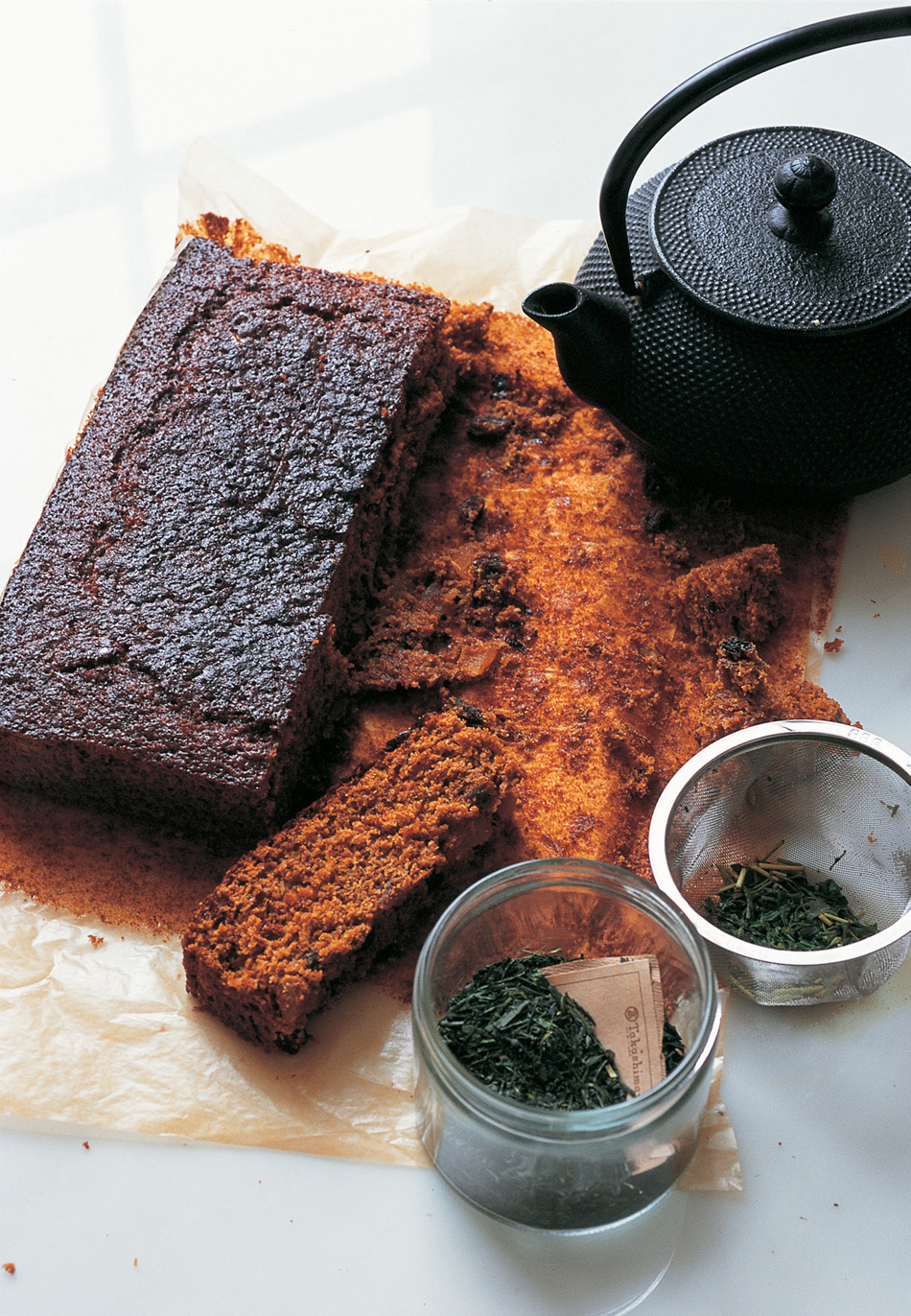
January 9
Rain and
an old-
fashioned
cake
This is the grey, endless drizzle that Britain is regularly accused of having, yet in truth we rarely see, even in the depths of winter. It’s the sort of day on which to light the fire, turn on the radio and bake a cake. Once the smell of baking fills the house, I find the rain suddenly matters a good deal less, if at all. I make a decent ginger cake, a love of which seems to run in our family. My Dad adored them, along with Battenburg, or ‘window cake’ as he called it, which I leave to the experts. I take mine in the afternoon with a pot of green tea.
Double ginger cake
I am rather proud of this cake. Lightly crisp on top and with a good, open texture, it is light, moist and delicately gingery. It will keep for a week or so wrapped in paper and foil.
self-raising flour – 250g
ground ginger – 2 level teaspoons
ground cinnamon – half a teaspoon
bicarbonate of soda – a level teaspoon
a pinch of salt
golden syrup – 200g
syrup from the ginger jar – 2 tablespoons
butter – 125g
stem ginger in syrup – 3 lumps, about 55g
sultanas – 2 heaped tablespoons
dark muscovado sugar – 125g
large eggs – 2
milk – 240ml
You will need a square cake tin measuring approximately 20–22cm, lined on the bottom with baking parchment or greaseproof paper.
Set the oven at 180C/Gas 4. Sift the flour with the ginger, cinnamon, bicarbonate of soda and salt. Put the golden and ginger syrups and the butter into a small saucepan and warm over a low heat. Dice the ginger finely, then add it to the pan with the sultanas and sugar. Let the mixture bubble gently for a minute, giving it the occasional stir to stop the fruit sticking on the bottom.
Break the eggs into a bowl, pour in the milk and beat gently to break up the egg and mix it into the milk. Remove the butter and sugar mixture from the heat and pour into the flour, stirring smoothly and firmly with a large metal spoon. Mix in the milk and eggs. The mixture should be sloppy, with no trace of flour.
Scoop the mixture into the lined cake tin and bake for thirty-five or forty minutes, until a skewer inserted in the centre of the cake comes out clean. Unless you are serving it warm, leave the cake in its tin to cool, then tip it out on to a sheet of greaseproof paper. Wrap it up in foil and, if you can, leave it to mature for a day or two before eating.
Enough for 8
January 11
Onion soup
without
tears
I do love the classic onion soup, simmered for hours in a deep iron pot, but if I’m honest I hate making it. Onions make me cry at the best of times, but slicing enough for an entire pan of soup is more than I can handle, so this method where you roast the halved onions first solves all that. But there is more to this soup than convenience for those easily brought to tears; the roasting of the onions gives a sweet, caramel depth to the broth and the onions turn silky, slithery and soft. I could also add that the smell of onions baking in butter is a rather more attractive option than the pong of boiled onions wafting through the house.
onions – 4 medium
butter – 40g
a glass of white wine
vegetable stock – 1.5 litres
a small French loaf
grated Gruyère, Emmental or other good melting cheese – 150g
Set the oven at 200°C/Gas 6. Peel the onions and cut them in half from tip to root, then lay them in a roasting tin and add the butter, salt and some pepper. Roast until they are tender and soft, and toasted dark brown here and there. You might have to turn them now and again.
Cut the onions into thick segments. Put them in a saucepan with the wine and bring to the boil. Let the wine bubble until it almost disappears (you just want the flavour, not the alcohol), then pour in the stock. Bring to the boil and simmer for about twenty minutes.
Just before you want to serve the soup, make the cheese croûtes. Cut the loaf into thin slices and toast lightly on one side under a hot grill. Turn them over and sprinkle with the grated cheese. Get the soup hot, ladle it into bowls and float the cheese croûtes on top. Place the bowls under a hot grill and leave until the cheese melts. Eat immediately, whilst the cheese is still stringy and molten.
Enough for 4
January 12
Potatoes
and cheese
for a cold
night
I rather like those dishes that can be eaten as either a side dish or a main course depending on what else you might be eating. They slot neatly into my ‘very useful’ category. This potato recipe is one of those. If we were having a few slices of cold roast beef or pork, or maybe some chicken left over from Sunday, then this is what I would want to eat with it at this time of year when the weather is so cold. Yet today two of us sit down each with a plate of these potatoes as a main course, with just a bowl of crisp winter salad of chicory, frisée and roughly hashed walnuts. Whichever way you look at it, it’s a rough-looking dish of cheese melting over the lightly fried potatoes.
It is not essential to stick to my choice of cheese. Anything that melts easily will do but both Fontina and Taleggio will melt superbly.
Cheese-smothered potatoes
waxy potatoes – 500g
olive oil – 2 tablespoons
butter – 50g
a medium-sized onion, sliced
garlic – 2 large cloves, finely sliced
thyme leaves – 1 tablespoon, chopped
easy melting cheese such as Taleggio or Fontina – 120g
Rinse the potatoes. There is no need to peel them unless the skins are very tough. Slice them thinly – about as thick as a pound coin. The thinner you slice them, the quicker they will cook.
Put the olive oil and butter in a shallow pan about 25cm in diameter and cook the onion and garlic in it for about five minutes, until they start to soften. Add the potatoes, some pepper and salt and the thyme to the pan and toss gently in the cooking fat. Cover with a lid and cook over a low heat for twenty-five minutes, turning once.
Test the cooked potatoes for tenderness. If the point of a knife slices into them easily, they are done. Slice the cheese thinly and lay it over the top of the potatoes. Cover the pan once more and continue cooking for a couple of minutes until the cheese has melted. Serve immediately, while the cheese is still soft and oozing.
Enough for 2
January 13
A velvety
soup for a
clear, cold
day
Crisp, clear, and the sky looks like Sweden. One of those days when you get tricked by the bright, crystal sky and go out with one layer too few, then come home freezing cold. I had every intention of bringing back something for supper but, after eating Turkish mezze at lunch, come home empty handed and end up scouring the fridge and cupboards for something to eat.
I never throw away Parmesan rinds. No matter how dry and cracked they get, the craggy ends are full of intense, cheesy flavour. A more organised cook would freeze theirs; mine tend to collect in one of the little plastic drawers in the fridge door, the one you are supposed to keep eggs in. To get the full, soothingly velvet texture of this soup, you will need a couple of large hunks of rind, about 5-6cm long. If the fridge is bare, then ask at your local deli. They may let you have them for little or nothing.
good-sized leeks – 3
butter – a thick slice, about 40g
potatoes – 3 medium-sized
Parmesan rinds
light stock or water – 1.5 litres
parsley – a handful
grated Parmesan – 6 tablespoons
Trim the leeks, slice them into thick rings, then wash thoroughly under cold running water. Melt the butter in a heavy-based pan (I use a cast-iron casserole), then tip in the washed leeks and let them soften slowly, covered with a lid, over a low to moderate heat. After about twenty minutes and with some occasional stirring they should be silkily tender.
While they are softening, peel the potatoes and cut them into chunks. Add them to the leeks when they are soft and let them cook for five minutes or so, before dropping in the cheese rinds and pouring in the stock or water. Season with salt and black pepper, then partially cover and leave to simmer for a good forty minutes.
Remove and discard the undissolved cheese rinds, scraping back into the soup any cheesy goo from them as you go. Add the leaves of the parsley and blitz the soup in a blender. Check the seasoning – it may need a surprisingly generous amount of salt and pepper – then bring briefly to the boil. Serve piping hot, with the grated Parmesan.
Enough for 6

January 15
I buy oysters today, fines de claire from the fish shop on Marylebone High Street, six apiece. They smell clean and slightly salty. The heavy-gauge oyster opener I bought five years ago has proved a sound investment, firmer and safer than its predecessor, which was, with hindsight, too flimsy to do the job. Opening oysters requires a no-messing attitude. Not exactly gung-ho, but with a certain amount of (mock) confidence. Even then I have to fish out bits of broken shell from the tender flesh and not-to-be-wasted juices. The shellfish was quite expensive, so I strike a balance with a cheap cupboard recipe to follow.
Bulghur wheat with aubergines and mint
Bulghur is one of those mild, warming grains that soothes and satisfies. I value it for its knubbly texture and nutty flavour. This, to me, is supper, but others may like to use it beside something else, such as grilled chicken or a gravy-rich stew.
olive oil – 6 tablespoons
a small onion
a bay leaf
aubergines – 2 small ones
garlic – 2 large cloves, chopped
bulghur wheat – 225g
vegetable stock – 500ml
tomatoes – 4
pine kernels – 3 tablespoons, toasted
mint – 15-20 leaves, chopped
lemon juice to taste
Warm the olive oil in a shallow pan, peel and finely slice the onion and let it cook slowly in the oil with the bay leaf. When the onion is soft and pale gold, add the aubergines, cut into 3cm pieces, and the chopped garlic. Let the aubergines cook, adding more oil if necessary, until they are golden and soft.
Pour in the bulghur wheat and the vegetable stock. Bring to the boil, then leave to simmer gently for fifteen to twenty minutes, till the wheat is tender and almost dry. Half way through cooking, roughly chop the tomatoes and add them. Once the wheat is cooked (it should still be nutty and have some bite), stir in the toasted pine kernels and chopped mint leaves. Check the seasoning; it will need lemon juice, salt and pepper.
Enough for 2, with seconds
January 17
A bench-
mark
Bolognese
No sooner is lunch over (supermarket sushi brought to life with enough wasabi to make my sinuses sting) than it starts to rain. The butcher has fresh mince, which looks straight from the mincer, the sight of which is enough to stir me into making a proper Bolognese. By which I mean one that has been left to blip and putter slowly on the stove, so that the flavours have a chance to mellow and deepen.
A really good spaghetti Bolognese
butter – 50g
cubed pancetta – 70g
a medium onion
garlic – 2 fat cloves
a carrot
celery – 2 stalks
flat mushrooms – 2 large, about 100g
bay leaves – 2
minced beef or lamb – 400g
crushed tomatoes or passata – 200ml
red wine – 200ml
stock – 200ml
a nutmeg
full-cream milk or cream – 200ml
To serve:
spaghetti or tagliatelle for 4
grated Parmesan
Melt the butter in a heavy-based pan – I use a cast-iron one about 24cm in diameter – then stir in the pancetta and let it cook for five minutes or so, without colouring much. Meanwhile peel and finely chop the onion and garlic and stir them into the pancetta. Scrub and finely chop the carrot and celery and stir them in, too. Lastly, finely chop the mushrooms and add to the pan, then tuck in the bay leaves and leave to cook for ten minutes over a moderate heat, stirring frequently.
Turn up the heat and tip in the meat, breaking it up well with a fork. Now leave to cook without stirring for a good three or four minutes, then, as the meat on the bottom is starting to brown, stir again, breaking up the meat where necessary, and leave to colour.
Mix in the tomatoes, red wine, stock, a grating of nutmeg and some salt and black pepper, letting it come to the boil. Turn the heat down so that everything barely bubbles. There should be movement, but one that is gentle, not quite a simmer. Partially cover the pan with a lid and leave to putter away for an hour to an hour and a half, stirring from time to time and checking the liquid levels. You don’t want it to be dry.
Pour in the milk or cream a bit at a time, stir and continue cooking for twenty minutes. Check the seasoning, then serve with the pasta and grated Parmesan.
Enough for 4
January 19
Sometimes I make my own chicken stock and sometimes I buy it ready-made. Today I take the lazy route, picking up a large tub from the butcher’s, idle, good-for-nothing guy that I am. The outcome is another ten-minute supper, which turns out to be more appreciated than any supermarket cook-chill dinner, at once warming (the broth), uplifting (lemon, mint) and satisfying (the noodles).
Chicken broth with noodles, lemon and mint
dried egg noodles – 50g
very good chicken broth – 1 litre
cooked chicken (leftover roast is fine) – 200g
chopped mint leaves – 2 heaped tablespoons
roughly chopped coriander leaves – 2 heaped tablespoons
the juice of a lemon
Drop the noodles into a deep pan of boiling, salted water and cook for two to three minutes, until tender. Drain them, rinse under cold running water, then leave to cool in a bowl of cold water until you need them.
Bring the chicken broth to the boil, then turn the heat down to a simmer. Shred the chicken with a sharp knife and add it to the simmering broth with the mint, coriander and lemon juice. Add the noodles, leave for one minute, then serve steaming hot in big bowls.
Enough for 2 as a main dish
January 21
A cheap fish
supper
I sometimes feel as if I am on a one-man mission to make the world eat more mackerel. This recipe, spiced with smoked paprika and rings of soft, golden onions, is one of the best I have come up with for this underrated fish. I am not sure you need anything more with it than some steamed spinach or spinach salad.
Spiced crumbed mackerel with smoked paprika
mackerel – 4, filleted
onion – 1 medium to large
olive oil
parsley – a handful
garlic – 3 small cloves
smoked ‘hot’ paprika – half a teaspoon
fresh breadcrumbs – 100g
a lemon
Rinse and dry the mackerel fillets and lay them skin-side down in a lightly oiled dish. Season them lightly with salt and pepper. Set the oven at 180°C/Gas 4.
Peel the onion and slice it into very thin rings, then let it cook over a moderate heat in a couple of tablespoons of olive oil until it starts to soften. Chop the parsley, not too finely, then peel and crush the garlic and stir into the onion with the paprika, a seasoning of black pepper and salt and the breadcrumbs. Pour in three tablespoons of olive oil.
Spoon the spiced breadcrumbs evenly over the fish and bake for twenty minutes. It is ready when the crumbs are golden and the fish is opaque and tender. Lift on to plates using a fish slice, then squeeze the lemon over each one.
Enough for 4
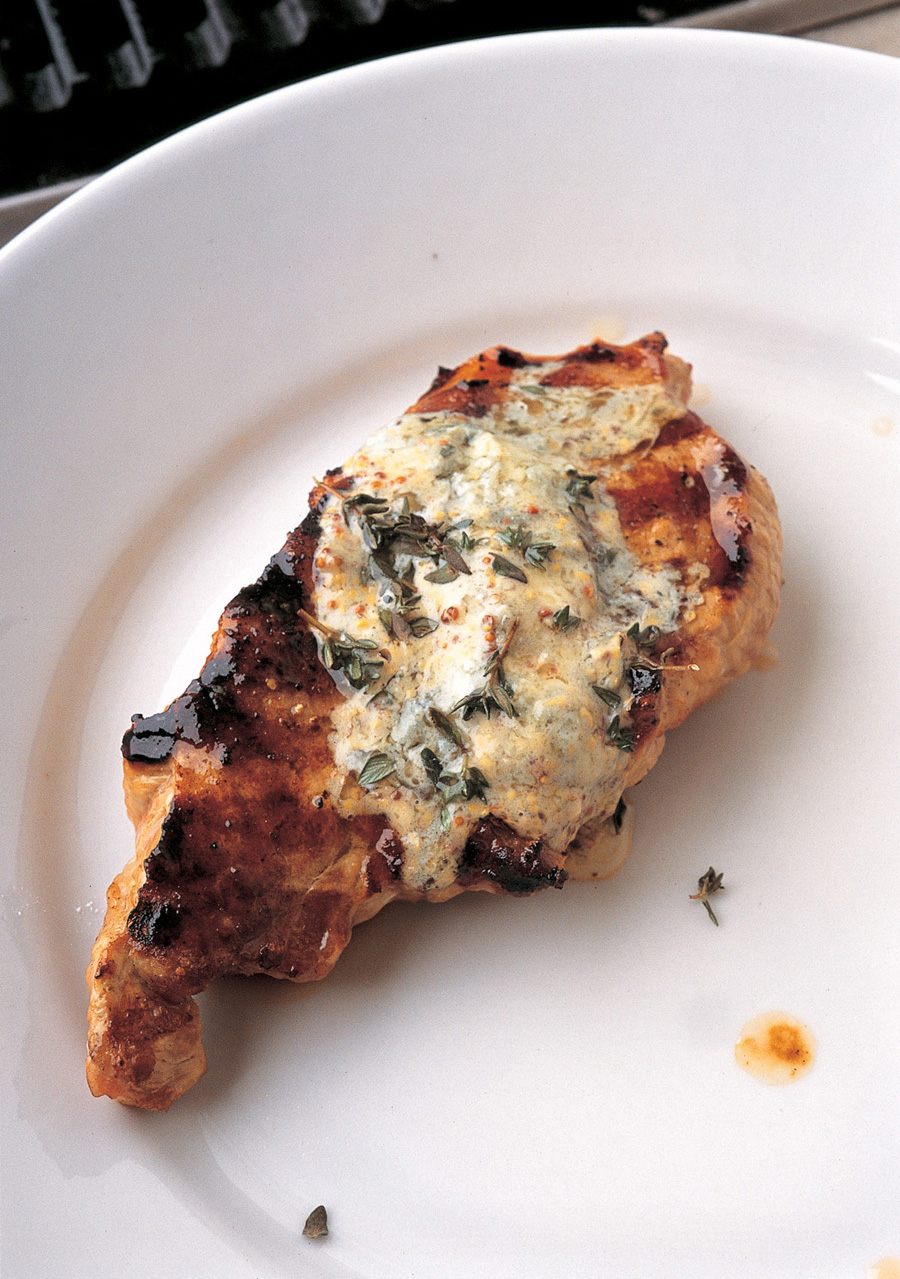
January 25
A herb
butter for
grilled
chops
I make a quick herb butter with equal amounts of blue cheese and butter (I use 100g of each), mashed with a tablespoon each of thyme leaves and Dijon mustard, then stir in a couple of tablespoons of double cream and a grinding of black pepper. It sits in the fridge till supper, when I lay thick slices of it on grilled pork steaks. The cheese butter melts over the charred edges of the chops, making an impromptu sauce to mop up with craggy lumps of sourdough bread.
No matter how beautiful its carmine and orange stalks, the sight of a bunch of chard in my organic bag always makes my heart sink. This is unfair. It’s a useful vegetable, with lush, heavily veined green leaves and enough colour to liven up even the greyest of winter days.
You can cook chard in a modicum of water, like spinach; it needs just enough to cover the stalks. I then drain it while the colours are still bright, say after six minutes or so, and drizzle it with olive oil, squeeze over masses of lemon juice and toss in a few green or black olives.
January 27
Cauliflower is something I can live without, but it surprises me today in a salad, lightly cooked, then drained and tossed with warmed canned chickpeas, plenty of lemon juice, good olive oil and coriander leaves. The crisp florets get a scattering of sesame seeds and a few stoned green olives. A pile of warm pitta bread finishes it off. Clean, lemony and fresh, this might prove a sound way to win other cauliflower haters round.
January 28
A pot-roast
bird and a
new cheese
On grey January days we must make our own fun. Today is a flat day that only seems to come to life when I go shopping, returning with bags of Italian lemons complete with their bottle-green leaves, craggy lumps of Crockhamdale and snow-white Ticklemore cheeses from Neal’s Yard Dairy and a cheap pheasant from Borough Market. There’s only two to feed, so a pheasant does nicely here. People get down about this time of year, but even today there were fat little partridges, clementines heavy with juice, and bunches of narcissi to cheer us up. There is good stuff if you are prepared to go and find it.
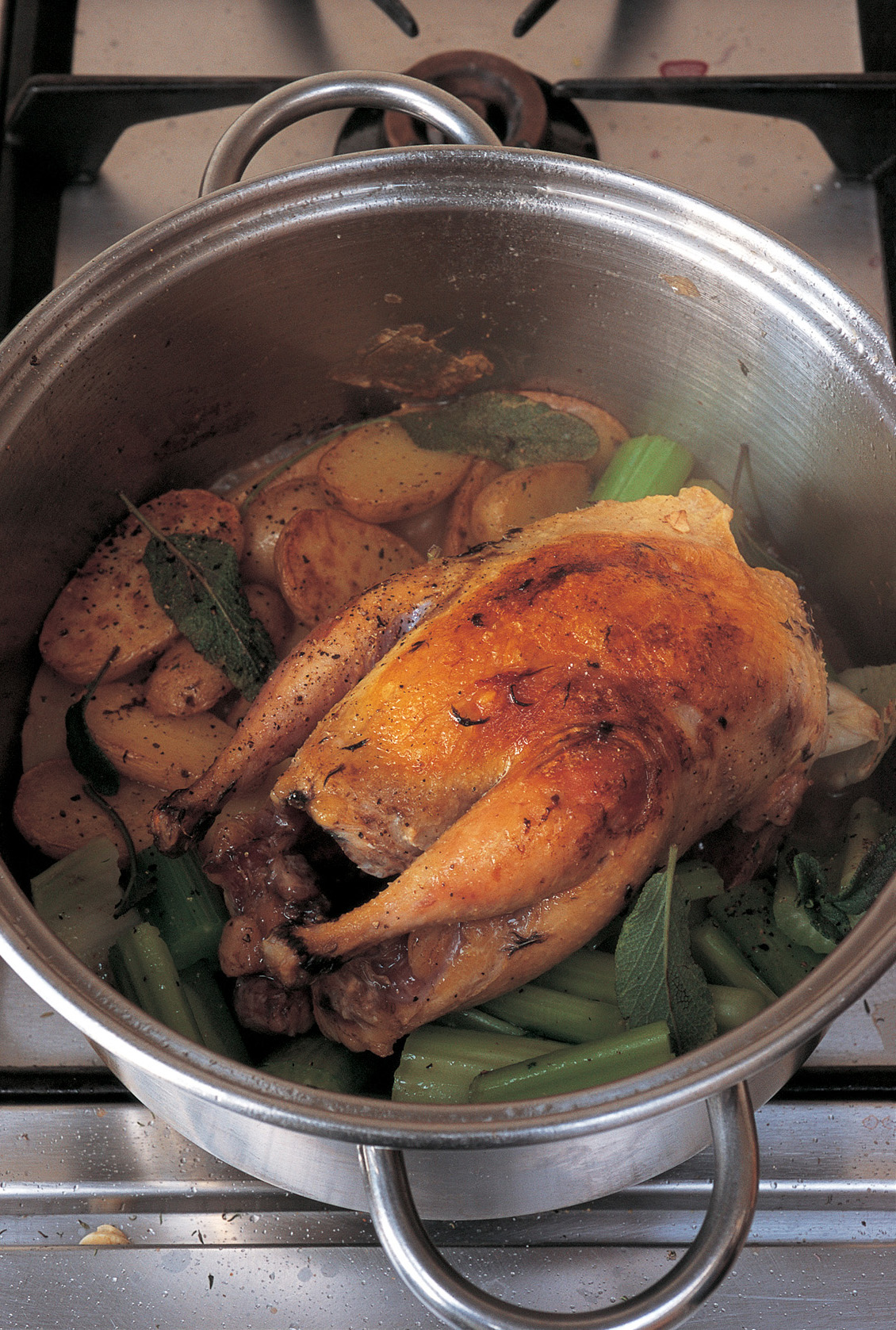
A pot-roast pheasant with celery and sage
The pheasant’s lack of fat means that we need to find ways of keeping its flesh moist during cooking. The time-honoured way is to wrap the bird in fatty bacon. Fine. But I don’t always want the intrusion of that particular flavour. Another way is to let the pheasant cook in its own steam. In other words, a pot roast. What you get is plenty of juicy meat that tastes of itself and plenty of clear, savoury juices.
a pheasant – plump and oven-ready
butter – 2 thick slices (80g)
garlic – 4 large, juicy cloves
celery – 3 large stalks and a few leaves
new potatoes – 12 smallish
sage – 6 decent-sized leaves
white vermouth such as Noilly Prat – 250ml
Set the oven at 180°C/Gas 4. Wipe the pheasant and remove any stray feathers, then season it thoroughly with salt and pepper.
Melt half the butter in a deep casserole, one to which you have a lid. You want it hot enough to brown the bird but not so hot that it burns too quickly. Put the bird in the hot butter, letting it colour heartily on all sides. When the skin is a rich gold, remove the bird, pour away the butter and wipe the pan with kitchen paper (the trick is to wipe away any burned butter but to leave any sticky goo stuck to the pan).
Whilst the bird is colouring in the butter, you can peel the garlic, trim the celery and cut it into short (2cm) lengths, wash the potatoes and either halve them or slice them thickly, depending on their size.
Melt the remaining butter in the pan and add the potatoes, letting them colour lightly. Then introduce the garlic, celery pieces and the sage and celery leaves and season with salt and pepper. Pour over the vermouth, bring to the boil, letting it bubble for a minute or two, then return the bird and any escaped juices to the pan. Cover with a lid and transfer to the oven for thirty-five to forty minutes.



